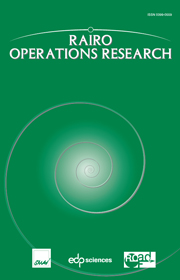Article contents
Advanced approach for the public transportation regulation system based on cybercars
Published online by Cambridge University Press: 08 February 2010
Abstract
In the last decade, the authorities require the use of safe, comfortable vehicles to assure a door to door aspect with respect of environment in the urban context. In this paper, we propose an advanced approach of transport regulation where we integrate cybercars into a regulation process as an alternative in disruption cases. For that, we propose an ITS architecture including public transportation and cybercars into the same framework. We will show that collaboration between these two systems provides better results than managing them separably.
- Type
- Research Article
- Information
- Copyright
- © EDP Sciences, ROADEF, SMAI, 2010
References
- 5
- Cited by


